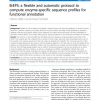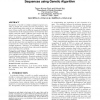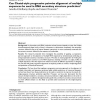281 search results - page 7 / 57 » Functional annotation of proteomic sequences based on consen... |
NAR
2006
13 years 7 months ago
2006
The FISH server is highly accurate in identifying the family membership of domains in a query protein sequence, even in the case of very low sequence identities to known homologue...
BMCBI
2010
13 years 4 months ago
2010
Background: Models for the simulation of metabolic networks require the accurate prediction of enzyme function. Based on a genomic sequence, enzymatic functions of gene products a...
NAR
2000
13 years 7 months ago
2000
SWISS-PROT is a curated protein sequence database which strives to provide a high level of annotation (such as the description of the function of a protein, its domains structure,...
GECCO
2006
Springer
13 years 11 months ago
2006
Springer
Recognition of motifs in multiple unaligned sequences provides an insight into protein structure and function. The task of discovering these motifs is very challenging because mos...
BMCBI
2007
13 years 7 months ago
2007
Background: In ribonucleic acid (RNA) molecules whose function depends on their final, folded three-dimensional shape (such as those in ribosomes or spliceosome complexes), the se...



